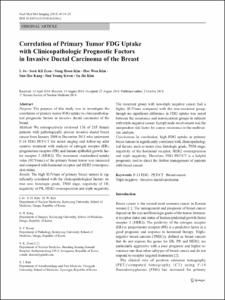KUMEL Repository
1. Journal Papers (연구논문)
1. School of Medicine (의과대학)
Dept. of Nuclear Medicine (핵의학)
Correlation of Primary Tumor FDG Uptake with Clinicopathologic Prognostic Factors in Invasive Ductal Carcinoma of the Breast
- Keimyung Author(s)
- Kim, Hae Won; Kang, Sun Hee; Kwon, Sun Young
- Journal Title
- Nuclear Medicine and Molecular Imaging
- Issued Date
- 2015
- Volume
- 49
- Issue
- 1
- Abstract
- Purpose The purpose of this study was to investigate the
correlation of primary tumor FDG uptake to clinicopathological
prognostic factors in invasive ductal carcinoma of the
breast.
Methods We retrospectively reviewed 136 of 215 female
patients with pathologically proven invasive ductal breast
cancer from January 2008 to December 2011 who underwent
F-18 FDG PET/CT for initial staging and follow-up after
curative treatment with analysis of estrogen receptor (ER),
progesterone receptor (PR) and human epithelial growth factor
receptor 2 (HER2). The maximum standardized uptake
value (SUVmax) of the primary breast tumor was measured
and compared with hormonal receptor and HER2 overexpression
status.
Results The high SUVmax of primary breast tumors is significantly
correlated with the clinicopathological factors: tumor
size, histologic grade, TNM stage, negativity of ER,
negativity of PR, HER2 overexpression and triple negativity.
The recurrent group with non-triple negative cancer had a
higher SUVmax compared with the non-recurrent group,
though no significant difference in FDG uptake was noted
between the recurrence and non-recurrent groups in subjects
with triple-negative cancer. Lymph node involvement was the
independent risk factor for cancer recurrence in the multivariate
analysis.
Conclusions In conclusion, high FDG uptake in primary
breast tumors is significantly correlated with clinicopathological
factors, such as tumor size, histologic grade, TNM stage,
negativity of the hormonal receptor, HER2 overexpression
and triple negativity. Therefore, FDG PET/CT is a helpful
prognostic tool to direct the further management of patients
with breast cancer.
Keywords F-18 FDG . PET/CT . Breast cancer .
Triple negative . Invasive ductal carcinoma
- Publisher
- School of Medicine
- Citation
- I. Jo et al. (2015). Correlation of Primary Tumor FDG Uptake with Clinicopathologic Prognostic Factors in Invasive Ductal Carcinoma of the Breast. Nuclear Medicine and Molecular Imaging, 49(1), 19–25. doi: 10.1007/s13139-014-0296-y
- Type
- Article
- ISSN
- 1869-3474
- 파일 목록
-
-
Download
 oak-aaa-03995.pdf
기타 데이터 / 347.59 kB / Adobe PDF
oak-aaa-03995.pdf
기타 데이터 / 347.59 kB / Adobe PDF
-
Items in Repository are protected by copyright, with all rights reserved, unless otherwise indicated.